SQUARE ENIX is one of the most renowned companies in the video game development industry, publishing popular franchises such as FINAL FANTASY, DRAGON QUEST, and KINGDOM HEARTS. The leadership behind cinematics for FINAL FANTASY XVI, its hit 2023 PlayStation 5 game, managed a large team of staff by successfully onboarding project management software and custom in-studio tools into the workforce. By adapting Flow Production Tracking for game development workflow, these leads facilitated better communication and coordination in the creative pipeline with little compromise towards a stunning final product.
Translated from Japanese. Original source

SQUARE ENIX released the latest numbered title in the 35-year franchise, FINAL FANTASY XVI (FF16) on June 22, 2023. It’s the first action game in the mainline series, and it adds more dynamic game elements to the story and graphics. As a PlayStation 5 exclusive at its launch, it also boasted more beautiful and rich visual expression than ever to tap into the console’s full potential.
Following up from previous talks with SQUARE ENIX staff in “How SQUARE ENIX made full use of Maya and MotionBuilder in FINAL FANTASY XVI | Combining technologies creates new expressions,” we now look at the team’s intensive progress management with Flow Production Tracking (formerly ShotGrid) tools.
Interviewees from SQUARE ENIX
SQUARE ENIX Co., Ltd.
Mr. Eitaro Iwabuchi (Lead Cinematic Technical Artist)
Mr. Takeo Suzuki (Cinematic Manager)

At SQUARE ENIX headquarters (from left): Mr. Iwabuchi and Mr. Suzuki
As workplace tasks grow complex, streamlining communication is vital
Today’s creators are facing a lot of information and never-ending tasks. Companies are looking for ways to streamline and automate operations, which is critical to improving the quality of their services and the workplace health of their employees.
However, they may face several obstacles: budgeting, know-how, having to staff engineers, maintenance and continuity between processes, and many more logistical issues that can stand in the way.
Furthermore, today’s work styles are becoming far more dynamic, with diversity in factors like staff positions, styles of communication, leadership, discretion, knowledge, and education levels.
Consequently, as the corporate world grows more complex, management roles are more important than ever, and their responsibilities need to be executed more skillfully than ever before.
A large-scale game development project such as FF16 can involve hundreds of people, requiring more intensive processes. There’s not only the standard “application, confirmation, and approval” flow, but also communication and asset exchanges across teams, progress and asset confirmation between teams, and frequent revisits of certain steps, which can slow down progress.
The right tools, such as Flow Production Tracking, can help solve communication errors and eliminate extraneous approval work, reducing the stress of artists so they can focus on the creative work that only humans can do.
How did SQUARE ENIX integrate Flow Production Tracking and improve its increasingly complex project management?
Help your team overcome barriers to entry
The first obstacle for introducing any software to a team of any size is overcoming its barriers of entry.
“Flow Production Tracking was already being used to manage the production of assets such as backgrounds and characters, but we hadn’t used it yet to manage the production of cut scenes,” said Cinematic Manager Takeo Suzuki.
While producing FF16, the team wanted to use Flow Production Tracking to improve efficiency in producing cut scenes. However, when introducing it, Eitaro Iwabuchi, the Lead Cinematic Technical Artist, thought that it was important not only to build a detailed flow, but also to gain the understanding of the staff.
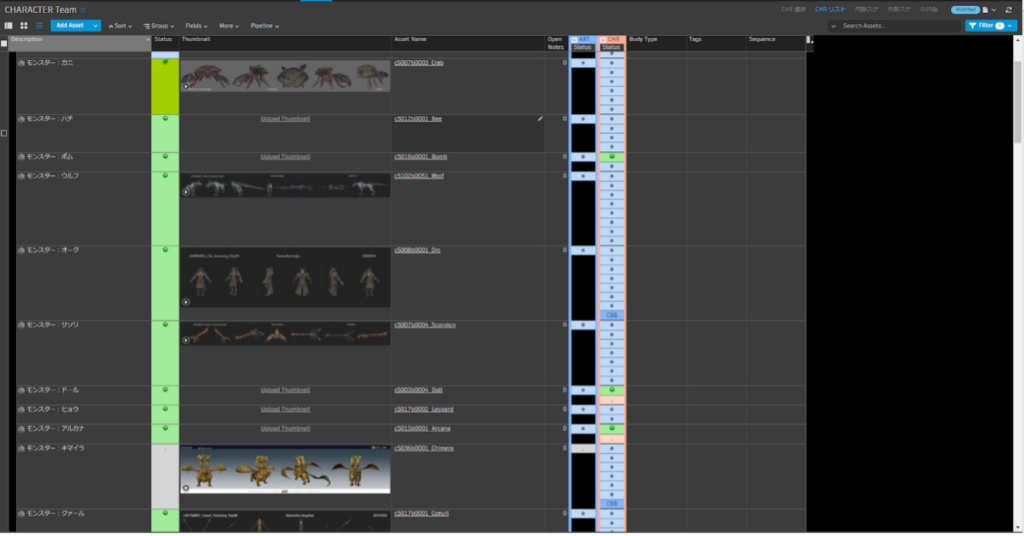
Asset progress management had already proven effective through Flow Production Tracking.
For similar projects in the past, communication was typically done by email using an in-house confirmation tool. Meanwhile, the team used homemade spreadsheets to manage overall progress, which resulted in scattered information and made it difficult to instantly grasp the situation or look back on it later.
“Since the production staff involves a wide range of people from both inside and outside the company, we thought that we could improve efficiency by unifying the common understanding with Flow Production Tracking,” Suzuki said. “We felt that there would be great benefits to introducing Flow Production Tracking for consolidating information in one place. Therefore, we decided to use what we’d learned through trial and error so far, and we held informational sessions to explain how to use it for each section, with detailed lectures to deepen all our staff’s understanding about its integration.”

Cinematic Manager Takeo Suzuki
Flow Production Tracking acts as a hub between the staff in charge of progress management and the creative team, merging the project’s flow and tasks into one place. It can help balance the workload, and check and adjust areas where delays are occurring, which can improve the entire project’s performance.
Iwabuchi explains that due to the sheer number of cutscenes in FF16 it was difficult to track who is in charge of a scene. Without a trail of accountability, we would often encounter problems without knowing who was responsible for them.
With Flow Production Tracking, “we were able to easily edit the layout of the page so that the person in charge of the cut could be identified immediately. In addition, the ‘review function’ that allows you to check and track the detailed history of interactions was very helpful.”
Plus, Iwabuchi appreciated that he could see at a glance where, why, and who was in charge of the status by looking at the history.
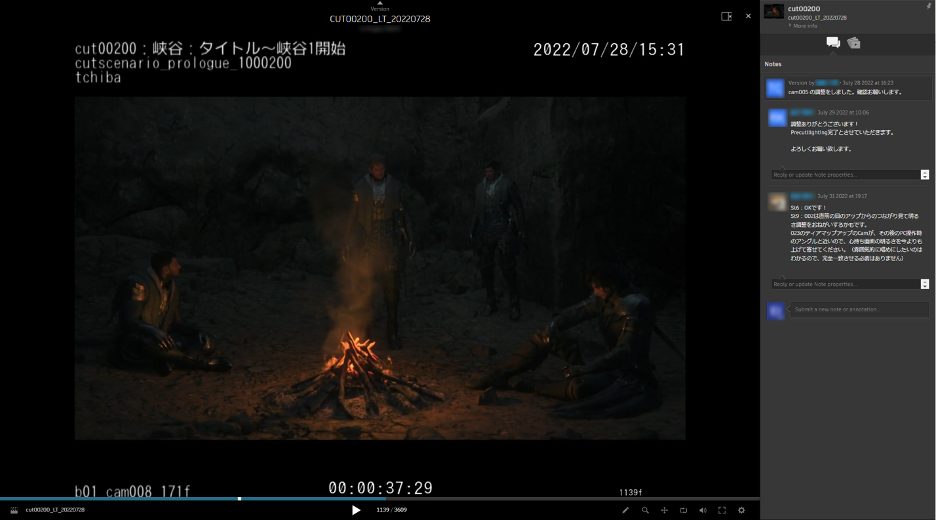
Directors can give precise feedback by writing instructions directly on any frame of the video.
Management tools to accommodate any workflow, from film to game development
Flow Production Tracking has been a must-have tool for film development, from Hollywood’s massive production hub to Japan for its renowned anime industry. In recent years, its use in video game development has also grown.
“Progress management of video production and cut scene production in game development may seem similar, but there are some differences,” Iwabuchi explained. “Game development involves a wider range of processes than video production, from the script to sound, and each section communicates closely with each other. We call this a ‘stage system,’ and we came up with a task management system using Flow Production Tracking that matches the ‘production flow across sections’ that is in line with the game development process.”
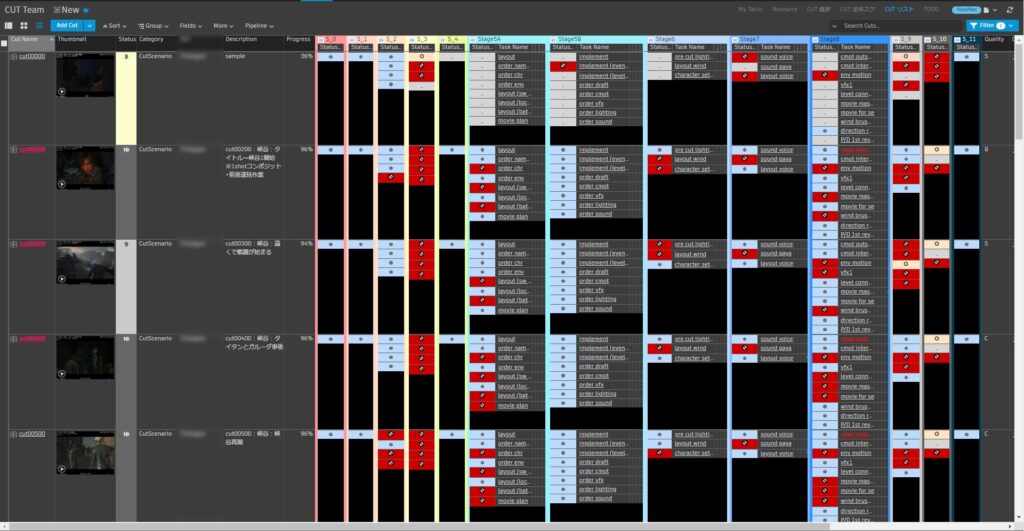
The schedule is organized in a “stage system.” Compared to video production, the number of tasks is much greater, with more than 50 units. It is divided into detailed sections such as “preparation,” “reading through,” “storyboard,” etc.
Here’s how: In film production, sound is often added in the final stages of the creation process—called post-production. While this is more static due to the nature of film, in game development, the sound must be played back during development while the movements and expressions are adjusted.
Ideally, the progress of sound recording and development of its affiliated data works in parallel with the animation editing tasks.
The FF16 team taps into Flow Production Tracking to organize these schedules and workflows through its unique internal flow management, their “stage system.”
“As you can see, there are quite a few differences between the flow of video production and game production, but I think Flow Production Tracking’s great appeal is its flexibility in absorbing these differences and being able to handle any workflow,” said Iwabuchi.

Lead Cinematic Technical Artist: Eitaro Iwabuchi.
Iwabuchi and Suzuki both make full use of Flow Production Tracking’s filtering tools that enable them to search and track data created by artists and staff. For example, they can filter it by cut number, file number, or staff member, allowing them to access the data easily, even at large-scale development sites that handle huge amounts of information.
“It’s a function that you should definitely make use of, as it allows you to filter data by a variety of conditions,” said Iwabuchi. “It’s extremely useful for progress management, as it lets you quickly find the information you need.”
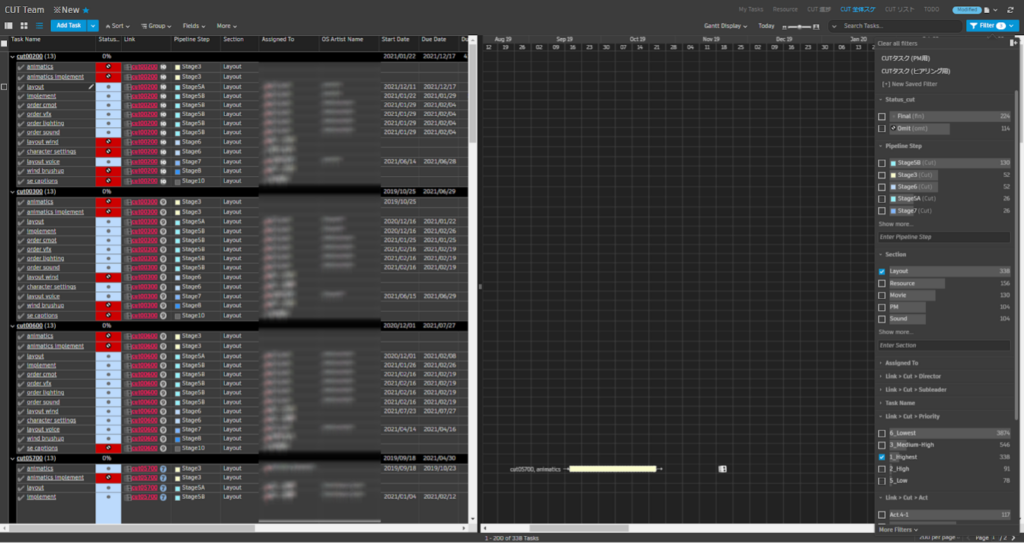
Filtering function: You can view a list of tasks that have not yet been completed in the previous process, and further narrow down the list by the person in charge. You can also customize the function to display only the cuts of the person in charge whose progress you want to check, and pick out only the parts you want to see.
The standard function allows users to receive email notifications for status changes and comments. However, SQUARE ENIX has developed a custom tool that automatically changes the status of the next process when the status of the previous process is changed and sends emails only to the relevant people.
“Since we are a large-scale development team, there is some variation in IT literacy, and so there are various ways of participating in the project,” said Iwabuchi. “By automatically changing the status, we were able to achieve a smooth handover between processes.
“Also, when using the standard function to send email notifications of required conditions, there were situations where a large number of emails were sent to a wider range of people than necessary. If you don’t make sure that the notifications you really need are sent to you, people won’t check the emails themselves, and they’ll miss things.”
With Flow Production Tracking’s flexibility and customization options, teams and projects of any size and type can manage their workflows as they see fit.
Introducing custom tools to augment Flow Production Tracking
So how did the FF16 team actually develop and operate custom tools for Flow Production Tracking?
“First, we prepared something like a design document,” Iwabuchi explained. “When designing, we thoroughly interviewed staff from all sections many times to clarify their needs, and made a list of requests from each section and team, such as what kind of process would be convenient for automatically changing the status and which stakeholders should be notified at that time. We prioritized the custom development to see what behavior would be desirable to make Flow Production Tracking even easier to use than the standard version.”
About 30 requests came in during the first interview stage. The developers responded to the requests by releasing and updating new custom tools throughout the project.
For FF16, they updated the Flow Production Tracking custom tools at the beginning of the week as part of “temporary internal maintenance.”
Throughout the deployment, there were a total of four major releases and about 20 small updates and releases.
While developing, deploying, and updating the custom features, several members of the management team shared various development tasks. They used a more hands-on approach, testing the behavior of status changes and email notifications one by one to eliminate any problems.
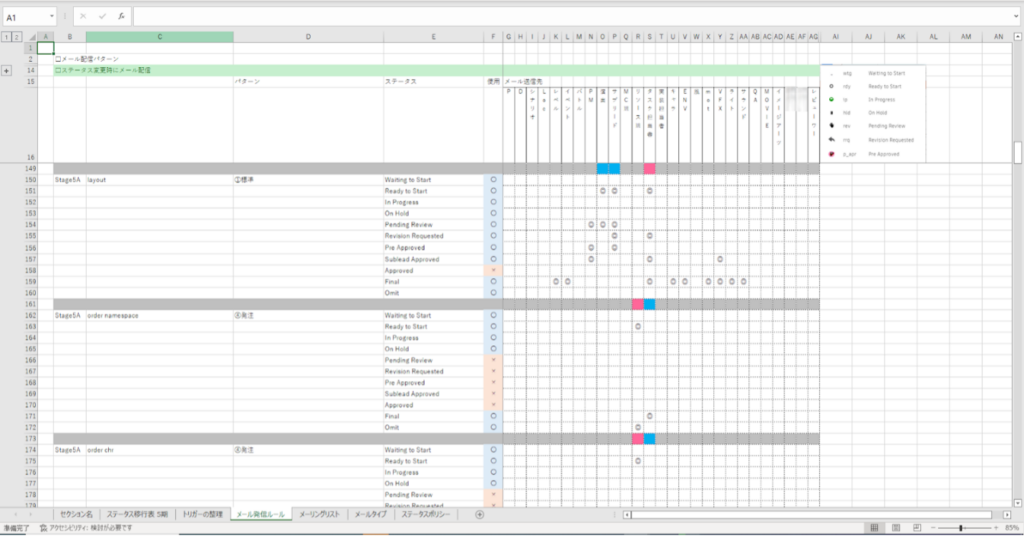
Design documents compiled based on feedback.
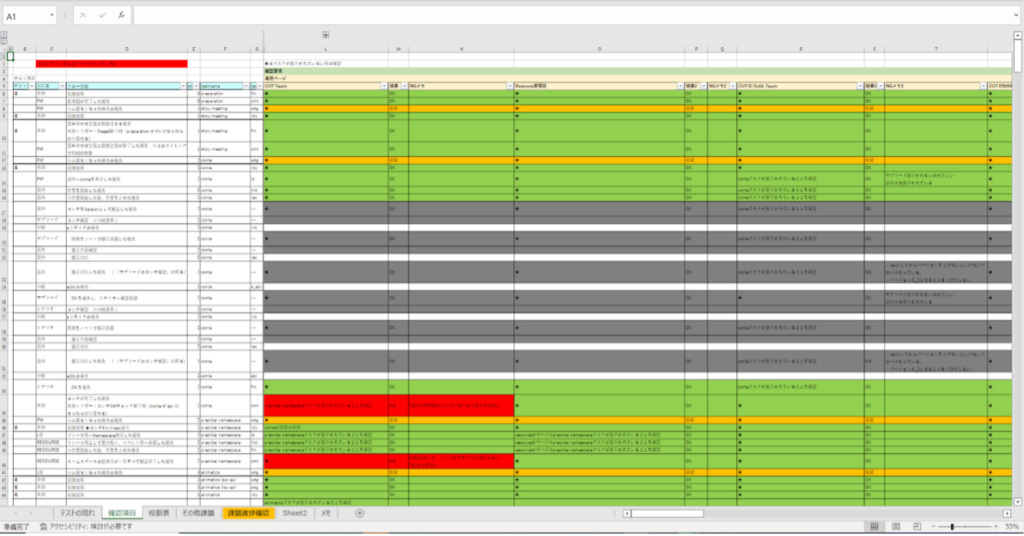
A list of items to check. Management checked the operational status of each item one by one.
Suzuki said that while Flow Production Tracking was the main tool for progress management, they also used Excel spreadsheets to check data along the way. The CSV output function in Flow Production Tracking proved extremely useful in this regard, especially in conjunction with other custom tools.
“You can export the necessary data from Flow Production Tracking in CSV format and then manage it by freely editing the way it’s displayed in Excel,” said Suzuki. “We also asked the development team to create a tool that would automatically output CSV files. Since the production status changes quickly and we needed to update it frequently, it was very helpful to be able to check the correct information based on Flow Production Tracking’s master data each time, even with a handmade management table.”


The team stores the latest information on Flow Production Tracking plus Excel sheets, automatically updated through custom tools.
An infrastructure tool to use with confidence
Iwabuchi calls Flow Production Tracking an “infrastructure tool” with its ability to build the foundation for comfortable workflow management, especially if the whole team puts its trust in it.
“Whether the staff could use it with confidence until the [project’s] end was what determined the success of the Flow Production Tracking introduction, and the management team was also conscious of that point,” Iwabuchi said.
Those who are hesitant about moving away from familiar routines and systems could benefit from a deeper introduction, a follow-up structure, and a system that would allow team members to use it comfortably.

Finally, we asked Iwabuchi and Suzuki to weigh in on the cost-effectiveness of Flow Production Tracking.
“There are many benefits, but the most cost-effective aspect is that it allows accurate information transmission and avoids miscommunication,” Iwabuchi said. “When a mistake occurs in transmitting information, it can take three people three days to follow up. I can’t say that Flow Production Tracking completely eliminated mistakes, but the reason that development proceeded smoothly throughout the project was because we were able to communicate more smoothly than before. I think that by introducing Flow Production Tracking, we were able to reduce the management costs by the amount of several people.”
By continuing to use Flow Production Tracking, SQUARE ENIX will accumulate ever more know-how, and as more team members become accustomed to it, the cost-effectiveness will also continue to increase.
Suzuki, on the other hand, says that you can get a feel for the cost-effectiveness of Flow Production Tracking by devising a way to set up your workflow: “There will probably be resistance if you try to run everything on Flow Production Tracking all at once, so it may be smoother to start using it for asset and cinematic shot management in a specific project or department, and then gradually expand its use. For example, as mentioned earlier, you can input and output CSV, so if you’re using Excel-based progress management, you could start by introducing it to that area. By choosing a method that suits your project and workflow, the costs should be justified.”
There’s the old adage, ” Start small.” This means moving forward little by little using what you have at hand rather than taking on a big venture right away.
It depends on the size of the project or company, and the budget, but if you are considering introducing Flow Production Tracking, a good option is to start small. By gradually increasing the proportion of use, Flow Production Tracking can become an ideal and powerful “project manager” for the team.
ORIGINAL TEXT (Japanese): Yuniko Mimura ( @UNIKO_LITTLE )
EDIT: SQUARE ENIX, Autodesk
Ready to switch your game development pipeline into turbo mode?